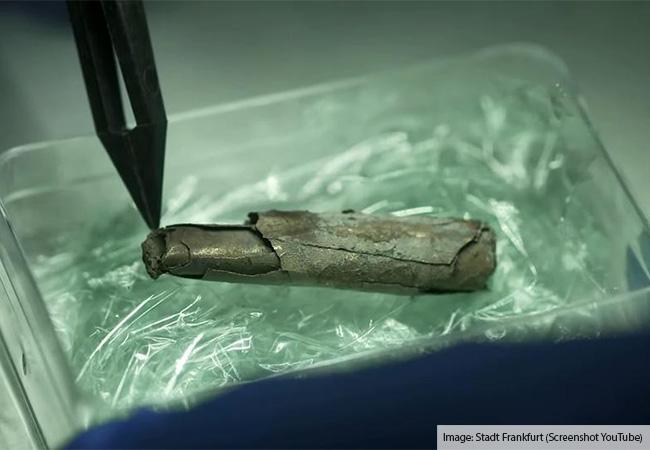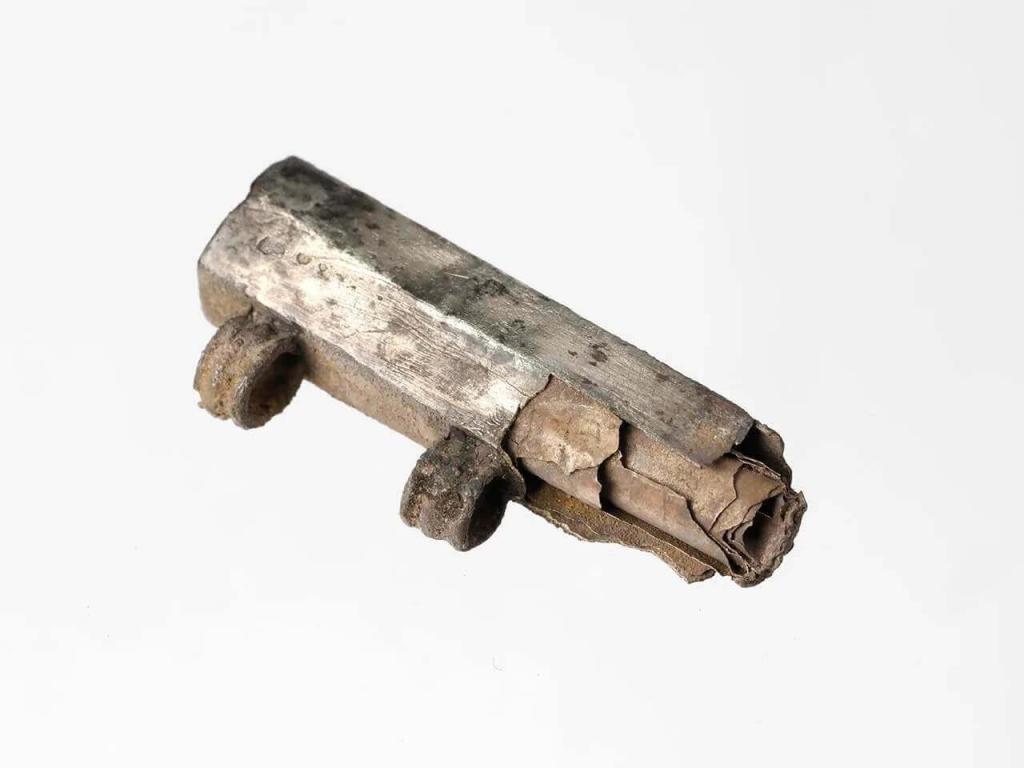Blog Category: Archaeology (5 posts)
Implications Of The Frankfurt Silver Amulet: Insights Into Early Christian Practice And Belief
Luke J. Wilson | 06th January 2025 |
Current Events
The discovery of an 1,800-year-old silver amulet in Frankfurt, Germany, has captured the attention of archaeologists and theologians alike. Known as the “Frankfurt Silver Inscription,” this artefact is the earliest known evidence of Christianity north of the Alps and serves as a great insight to early Christian theology and liturgical practice.
Its early date (230–270 AD) sets it apart from previously known artefacts, which are at least 50 years younger. While there are historical references to Christian communities in Gaul and Upper Germania during the late 2nd century, reliable material evidence of Christian life in the northern Alpine regions generally only dates to the 4th century. This amulet offers new insights into the life and faith of early believers, revealing their theology, liturgical practices, and adaptation of existing traditions.
1. Invoking St. Titus: A Connection to Apostolic Roots
One of the most remarkable features of the inscription is its invocation of St. Titus, a disciple and confidant of the Apostle Paul. This early reference highlights the theological importance of Apostolic authority and continuity. Titus, known for his leadership within the early church, symbolises the rootedness of Christian faith in the teachings and mission of the Apostles.
In this context, the invocation of a saint also invites a deeper exploration of the “cult of saints,” a term scholars use to describe the veneration of saints within Christian tradition. The cult of saints became a significant aspect of Christian worship in the 4th and 5th centuries, with practices such as the commemoration of martyrs, the dedication of churches to saints, and the belief in their intercessory power. The earliest documented evidence of this practice, including the veneration of relics and the dedication of feast days, often centres on martyrs who bore witness to their faith during times of persecution.
However, the invocation of St. Titus in the “Frankfurt Silver Ins...
Ancient Amulet Rewrites History Of Christianity In Europe
Luke J. Wilson | 18th December 2024 |
Current Events
New discovery proclaims Jesus as “Son of God” a century earlier than previously thought.
An exciting archaeological discovery has recently come to light: researchers have unearthed an 1800-year-old silver amulet in Frankfurt, Germany. This amulet provides the earliest known evidence of Christianity north of the Alps and disrupts previously held ideas about the spread of the faith, namely that Christianity didn’t get to the German region around the fourth century.
The amulet, dating from approximately 230 to 270 AD, was found in 2018 beneath the chin of a man’s skeleton during excavations at a Roman burial site near the former town of Nida, now part of Frankfurt’s northwestern suburbs.
3rd-century burial with silver amulet at the neck. Credit: Michael Obst, Monument Office of the City of Frankfurt am Main
Inside the amulet was a delicate silver scroll, measuring about 91 millimetres in length, inscribed with an 18-line Latin text. Due to the fragility of the foil, researchers employed advanced imaging techniques, including computed tomography (CT) scans, to virtually unroll and decipher the inscription.
Inscription digitally unscrolled. Credit: LEIZA. / Prof. Dr. Markus Scholz
The inscription invokes Jesus Christ's name, identifying Him as the “Son of God,” and includes a Trisagion (“holy, holy, holy”), marking the earliest known use of this liturgical phrase. It also quotes lines from the Epistle to the Philippians (Philippians 2:10–11) in an early Latin translation, demonstrating the early dissemination of Pauline theology in this region.
This discovery challenges previous understandings of the spread of Christianity in Europe, suggesting that devout Christian communities existed north of the Alps earlier than previously documented. Before this find, the earliest reliable evidence of Christianity in this area was associated with Maternus, bishop of Cologne, who participated in the Synod of Rome in 313 AD.
Translation of the Ins...
Jesus Like You've Never Seen Before - Discoveries from Early Christian Art
Luke J. Wilson | 13th May 2023 |
General Articles
I recently made a video on TikTok about what Jesus looks like in religious art and icons across various cultures, showing that people see Jesus as relatable to them and their people groups, and thus often depict Jesus looking the same as their own race. There was a comment made claiming that the Christ Pantocrator icon is exactly what Jesus looked like, and thus all others are wrong. If you’re wondering about the icon name, Pantocrator (Greek: Παντοκράτωρ) literally means “ruler of all”, but usually gets translated as “Almighty” or “all-powerful”.
The oldest known icon of Christ Pantocrator,6th-century encaustic icon fromSaint Catherine’s Monastery, Mount Sinai
The claim that we definitely know what Jesus looked like is an intriguing one, especially related to the Christ Pantocrator icon. This image, as far as we know, only exists in its oldest form from the 6th or 7th century. This particular icon was initially painted in Saint Catherine’s Monastery in Sinai, which was built in the late 6th century. Therefore, the image itself cannot be older than the monastery, at least not in this location.
However, we have earlier icons of Jesus dating back to the 3rd and 4th century. One such example from the 4th century is a depiction of a woman being healed by touching the hem of Jesus’s robe.
Jesus Healing a Bleeding Woman, c. 300–350
Interestingly, the older these images get, the more “Roman” Jesus tends to look. These Roman-like depictions often present Jesus as a younger, clean-shaven figure with short hair, which contrasts with the more traditional images that we’ve come to associate with Jesus — an older, bearded figure.
In iconography, the beard and age often symbolises wisdom and the role of a teacher. On the other hand, the older Roman-like depictions tend to present Jesus as a typical person of the day, as seen by the artists of that time.
Moving further back in time, we find depictions from the 3rd century...
Scientist Uncovers Hidden 1,750-Year-Old New Testament Translation with Ultraviolet Imaging
Luke J. Wilson | 17th April 2023 |
Current Events
A scientist has reportedly uncovered an ancient translation containing sections of the Gospel of Matthew, believed to be the sole surviving evidence of the fourth manuscript supporting the Old Syriac version of the Gospels.
The research team, which includes medieval expert Grigory Kessel from the Austrian Academy of Sciences (OeAW), employed ultraviolet imaging to reveal the ancient translation concealed beneath three layers of text.
The research, published last month in the journal New Testament Studies, presents an interpretation of Matthew 11:30 to Matthew 12:26, initially translated as part of the Old Syriac translations around 1,500 years ago.
According to the British Library, Syriac was an Eastern Aramaic dialect utilized by the Church in Syria and various Middle Eastern countries from the first century through the Middle Ages. While it used the same alphabet as Hebrew, the Syriac language featured distinct characters.
The study indicates that the Gospel book was undoubtedly created no later than the sixth century. Comparisons with dated Syriac manuscripts help narrow the time frame to the first half of the sixth century.
An OeAW statement released earlier this month reveals that the text was created in the third century and replicated in the sixth century. Over a millennium ago, an ancient Israeli scribe erased a Syriac Gospel book to repurpose it, since parchment was a rare resource in the desert during the Middle Ages and frequently reused.
Kessel explains that Syriac Christianity encompasses multiple translations of the Old and New Testaments. Until recently, only two manuscripts containing the Old Syriac translation of the Gospels were known.
The fragment of the translation of the New Testament is visible under UV light © Vatican Library
One of these fragments is housed at the British Library in London, while the second fragment, a "palimpsest" or reused manuscript that retains traces of its original form, was discovered at St. Catherine's...
Ancient “curse” amulet drastically changes perspective on Biblical dating
Luke J. Wilson | 26th March 2022 |
Current Events
On Thursday at ancient Shiloh, Dr. Scott Stripling, director of excavations for the Associates for Biblical Research (ABR), presented new findings which may well be one of the most significant discoveries in biblical archaeology in recent times!
More than thirty years ago, Prof. Adam Zertal discovered a small lead amulet, only two centimetres square, from wet-sifting material taken from an excavation on Mount Ebal. This came from a square altar dated from the 13th century BC, which had been built on top of an older and circular altar. Prof. Zertal believed this was the same altar Joshua built when he entered the land of Israel:
Josh. 8:30Then Joshua built on Mount Ebal an altar to the Lord, the God of Israel
Dr. Stripling’s team rediscovered this in 2020, yet the metal amulet still remained a mystery.
New technology enabled archeologists to read the ancient amulet
The amulet was folded in half and had letters inscribed into the foil — but they were indecipherable and the metal was now too brittle to unfold without destroying the whole thing. Reaching out to a team of researchers in Prague, the ABR team had them use tomographic scans similar to medical CT scans to reveal the long hidden text.
The scans revealed something very unexpected: an ancient proto-alphabetic Hebrew inscription composed of 40 letters! These are centuries older than any other known Hebrew inscription from ancient Israel and now challenge everything archaeologists and Biblical scholars thought they knew.
Specialists in deciphering ancient texts, known as Epigraphers, Pieter Gert van der Veen of Johannes Gutenberg-Universität Mainz and Gershon Galil of the University of Haifa, determined that the lead amulet was what is known as a defixio: a curse tablet.
On the amulet, the word “cursed” appears 10 times, along with the tetragrammaton — the four letter name of God, YHWH in English. Below is the text of the amulet:
Cursed, cursed, cursed — cursed by the God YHWH.Yo...






